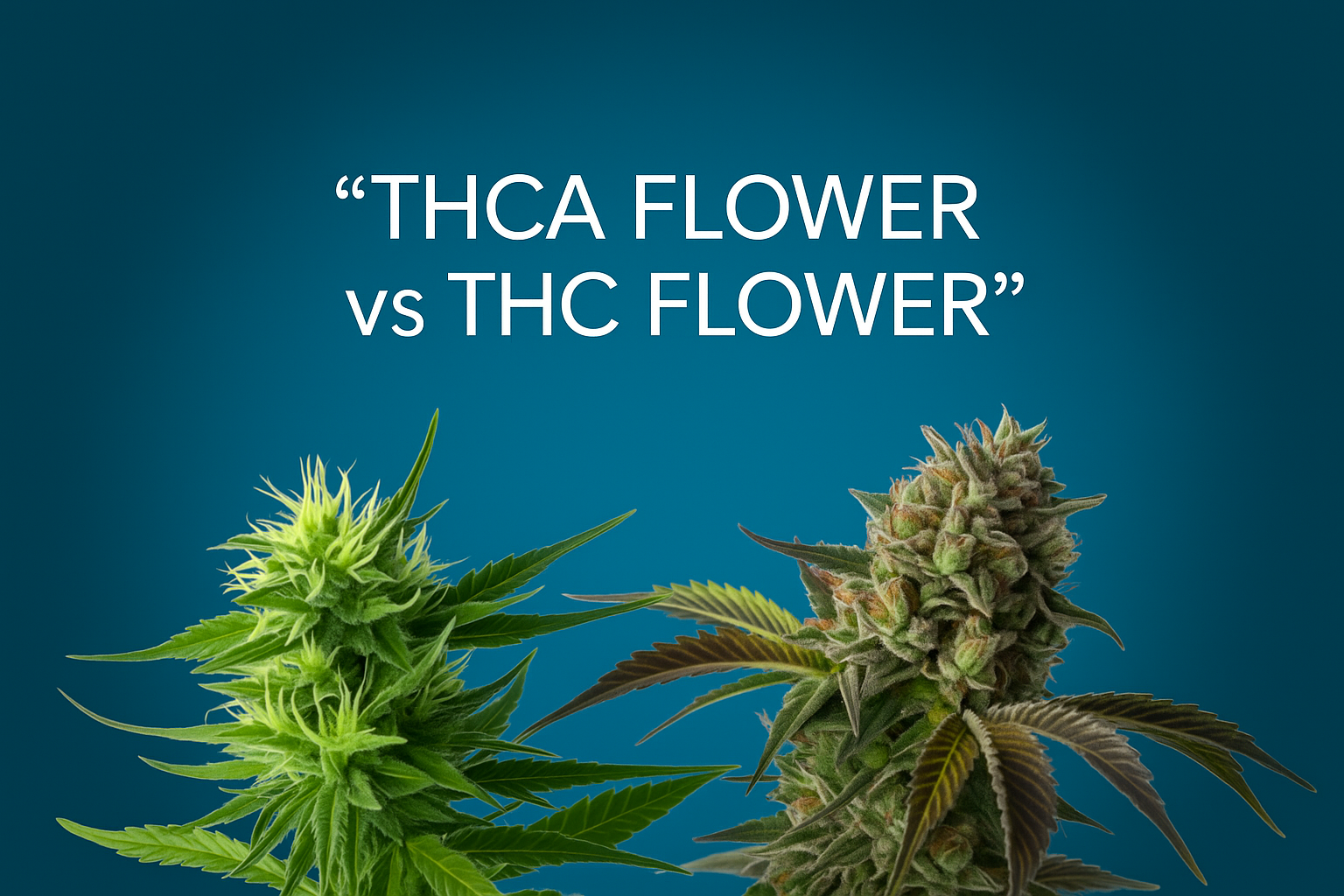The Truth About THCA Flower — And Why It Gets You High

Key Takeaways
- THCA ≠ THC — until you add heat. THCA is the raw, non-psychoactive version of THC that becomes intoxicating once smoked, vaped, or baked.
- THCA flower is real cannabis, not CBD or hemp. Once heated, it’s chemically identical to dispensary weed.
- The Farm Bill loophole allows sellers to market intoxicating products as “hemp” because only Δ9-THC is restricted — not THCA.
- Quality, safety, and legality vary widely. Some online THCA flower is top-shelf, while others are untested and unsafe.
- Smart buyers always check for complete lab reports (COAs), “total THC” values, and transparent sourcing.
The Real Difference Between THCA and THC
Most cannabis users know what THC is — it’s the compound that gets you high. But THCA? That’s where things get murky.
THCA (Tetrahydrocannabinolic Acid) is the acidic precursor to THC. It’s found naturally in raw cannabis, and it’s completely non-psychoactive. You could eat a handful of raw cannabis buds and not feel a thing — except maybe a strong grassy taste.
But once you apply heat, THCA decarboxylates, meaning it loses a carbon atom (CO₂) and transforms into THC (Delta-9-Tetrahydrocannabinol) — the psychoactive molecule responsible for the “high.”
So, when you smoke, vape, or bake THCA-rich flower, you’re not consuming THCA anymore — you’re consuming THC.
In other words: THCA is just THC waiting to happen.
What You’re Actually Buying When You Order “THCA Flower”
Let’s be blunt: when you buy THCA flower online, you’re buying weed — just marketed under a different name.
The difference isn’t in the plant itself but in the paperwork and testing loophole.
Here’s how sellers do it:
- The 2018 U.S. Farm Bill legalized hemp containing no more than 0.3% Delta-9 THC (dry weight).
- It didn’t include THCA in that definition.
- Growers produce cannabis that’s low in Delta-9 THC but high in THCA.
- Labs test only for Delta-9 THC — not the total potential THC once heated.
- Result: it’s legally “hemp” on paper, even though it becomes potent THC when smoked.
That’s the loophole. It’s why companies can advertise “legal THCA flower” that delivers a full cannabis high. Chemically, the flower is identical to dispensary-grade marijuana. The only difference is how it’s labeled and regulated.
How the Loophole Works
When the Farm Bill passed in 2018, lawmakers were focused on industrial hemp — CBD, textiles, food supplements — not recreational cannabis.
They defined legality by Delta-9 THC concentration, the psychoactive compound, assuming that was enough. But they didn’t anticipate how chemistry and marketing would evolve.
Fast forward a few years, and hemp labs and retailers realized that THCA converts to Delta-9 THC when heated — meaning you could legally sell weed that tests “low” but smokes “high.”
Some brands even time their lab tests to ensure low Delta-9 readings (for example, testing before drying, when THCA hasn’t fully formed). Others shop around for lenient labs or report only selective numbers.
The result is a thriving gray market where high-potency cannabis is shipped across the U.S., labeled as “hemp.”
The Quality Divide: Hemp vs. Dispensary Weed
One thing that varies wildly is quality.
Top-tier THCA brands source their flower from the same controlled environments used by licensed cannabis growers, featuring indoor lighting, optimized nutrients, proper curing, and detailed lab testing.
But others don’t.
Because “hemp” isn’t regulated the same way as cannabis, there’s no universal requirement for:
- Microbial testing (mold, mildew)
- Heavy metal screening
- Pesticide analysis
- Proper moisture or curing standards
That means the bag of “THCA flower” you order online could range from clean, premium buds… to poorly handled, contaminated biomass.
Visually, they might look identical — frosty, aromatic, covered in trichomes — but only one is safe to smoke.
How to Buy THCA Flower the Smart Way
If you’re shopping online, here’s how to stay as safe as possible and avoid scams:
1. Demand transparent COAs (lab reports).
A real COA should list both Δ9-THC and THCA and calculate Total THC = (THCA × 0.877) + Δ9-THC. If you only see one number, or the lab name looks shady — skip it.
2. Research the brand’s reputation.
Look for consistent batch testing, verified customer feedback (including reviews), and visible growth locations. Hidden origins are a red flag.
3. Check freshness.
Old THCA flower may degrade, losing potency or developing mold. Good sellers list harvest dates and storage conditions.
4. Know your state law.
Several states — including Colorado, Oregon, Minnesota, and Hawaii — have already banned or restricted high-THCA hemp. Others are reviewing legislation.
5. Understand what you’re consuming.
Once you light it, it’s THC, and your body will metabolize it that way. That means it can still show up on drug tests — “hemp” label or not.
Why the Loophole Is Closing Fast
Regulators have started to catch up. Several states have rewritten their hemp laws to include “total THC” rather than just Delta-9 THC.
Federal reform is also on the horizon — Congress has already proposed revisions to the Farm Bill that would redefine hemp as cannabis containing less than 0.3% total THC, effectively counting THCA toward the limit.
That would shut down most of the online THCA flower market overnight.
But until that happens, sellers are operating in a gray zone — technically compliant, but skating on thin ice.
The Future of THCA Flower
The THCA boom might be a temporary loophole era, similar to the rise and fall of Delta-8 THC products.
Once total-THC testing becomes standard, the focus will likely shift toward regulated cannabis markets where quality and transparency are enforced.
That said, the THCA trend shows one thing clearly: consumer demand for cannabis is strong — everywhere. People want access to safe, high-quality flower without fear or stigma.
As legalization spreads, expect to see more alignment between hemp and cannabis regulations, with them being merged into a single, consistent framework.
Conclusion
If you smoke or vape THCA flower, you’re getting THC — plain and simple.
The “hemp” label doesn’t change the chemistry or the high; it only changes the legal risk.
So buy smart, stay informed, and support brands that prioritize transparency and safety over quick profits.
As consumers become more educated, it becomes increasingly difficult for shady sellers to hide behind fine print.
Have you had your own experiences with THCA products? If yes, please let us know in the comments.








I had already known all of this prior to reading it. However, a couple of things to point out.
I don’t think there are ANY online THCa hemp ‘companies’ out there at this time that don’t pay for false results or have them doctored in some way when it comes to these COAs. Cannabis flowers do not hold more than 28-30% THCa. Why? Because it’s not possible for the flower to hold that much THCa. Also, the higher the THCa, the lower the levels of terpenes will be. Seeing as THCa is only one of the cannabinoids on the flower, the terpenes are severely lacking. This in turn, effects the taste, aroma and the overall experience (high) of consuming truly full-spectrum cannabis. Some consumers just don’t get i, and I can’t blame them. Even I , a cannabis consumer for over 46 years, had a problem understanding this whole THCa thing. Come to find out, it’s all just a scam for these sellers to make a lot of money.
Yes, this flower will give you some feeling of being high, but in my experience, lower levels of THCa and higher levels of other cannabinoids / terpenes make the experience much better. All this THCa flower seems to do is make you tired and can give you high anxiety.
These sellers don’t care, They want your money, and they are sure are getting it. So if there is anyone out there who reads these COAs and believes in them, especially the lab tests that are listed that supposedly show the levels of heavy metals, arsenic, PGRs etc., I feel sorry for you and your lungs.
Just one more thing. I mentioned PGRs. These are synthetic plant growth regulators. These chemicals are VERY dangerous to consume on ANY level! When you see flower in a jar, bag or even on the plant itself, and you notice the flowers are absolutely almost completely covered in pistils (orange / red or whichever colored ‘hairs’), DO NOT smoke those! I like my flower to have these pistils. They make your flower look better. Unfortunately, I’ve learned that these ‘hairs’ do absolutely nothing toward the high you get from the flower. Nor do they add any flavor or give off any aroma. They are simply there to collect airborne pollen from the male plant. Sorry, but it’s true. Perhaps with better testing we will find out some new information, but yeah, they don’t do anything, but make the flower look better to some. (Some like me.)
Sorry to ramble-on a bit here.